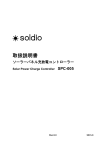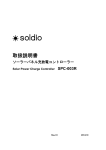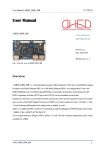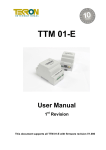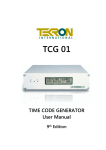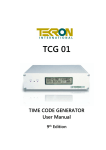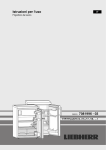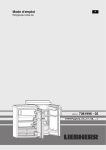Download National Instruments NI PCI-6542 User's Manual
Transcript
GETTING STARTED GUIDE NI Digital Waveform Generator/Analyzer This document explains how to install, configure, test, and set up a National Instruments digital waveform generator/analyzer. This document applies specifically to the following devices: • NI PXI/PCI-6541/6542 (NI 654X) • NI PXI/PCI-6551/6552 (NI 655X) • NI PXI-6561/6562 (NI 656X) For more information about features and programming, refer to the NI Digital Waveform Generator/Analyzer Help at Start»Programs» National Instruments»NI-HSDIO»Documentation» NI Digital Waveform Generator/Analyzer Help. Refer to the specifications document that ships with your device for detailed specifications. For free downloads of the most current versions of product documentation and example programs, visit ni.com/instruments. Contents Conventions ...............................................................................................2 1. Verifying the System Components ........................................................4 Minimum System Requirements .......................................................4 Recommended System.......................................................................4 2. Unpacking ..............................................................................................5 3. Verifying the Kit Contents.....................................................................6 Documentation...................................................................................6 EMI Gasket (NI PXI-655X Only) ......................................................6 4. Installing the Software ...........................................................................6 Choose and Install Your ADE ...........................................................6 Install NI-HSDIO...............................................................................7 (Optional) Install the NI Digital Waveform Editor ...........................7 January 2005 373308E-01 5. Installing the Hardware..........................................................................8 Installing a PXI Module.....................................................................8 Installing a PCI Device ......................................................................10 6. Configuring and Testing in MAX..........................................................11 Using the Test Panel to Generate and Acquire Data .........................12 7. Connecting Signals ................................................................................14 Connecting Cables and Accessories ..................................................14 Wiring for Common Measurements ..................................................16 8. Programming the Digital Waveform Generator/Analyzer.....................18 NI-HSDIO Instrument Driver ............................................................18 NI-HSDIO Examples .........................................................................18 Appendix A: Device Front Panels .............................................................18 Appendix B: Troubleshooting ...................................................................26 Technical Support Resources.....................................................................28 Conventions The following conventions are used in this guide: <> Angle brackets that contain numbers separated by an ellipsis represent a range of values associated with a bit or signal name—for example, DIO <3..0>. » The » symbol leads you through nested menu items and dialog box options to a final action. The sequence File»Page Setup»Options directs you to pull down the File menu, select the Page Setup item, and select Options from the last dialog box. This icon denotes a tip, which alerts you to advisory information. This icon denotes a note, which alerts you to important information. This icon denotes a caution, which advises you of precautions to take to avoid injury, data loss, or a system crash. When this symbol is marked on the product, refer to the Read Me First: Safety and Radio-Frequency Interference document that shipped with your device for precautions to take. bold Bold text denotes items that you must select or click in the software, such as menu items and dialog box options. Bold text also denotes parameter names. NI Digital Waveform Generator/Analyzer Guide 2 ni.com CompactPCI CompactPCI refers to the core specification defined by the PCI Industrial Computer Manufacturers Group (PICMG). italic Italic text denotes variables, emphasis, or a cross reference. This font also denotes text that is a placeholder for a word or value that you must supply. monospace Text in this font denotes text or characters that you should enter from the keyboard, sections of code, programming examples, and syntax examples. This font is also used for the proper names of disk drives, paths, directories, programs, subprograms, subroutines, device names, functions, operations, variables, filenames, and extensions. monospace bold Bold text in this font denotes the messages and responses that the computer automatically prints to the screen. This font also emphasizes lines of code that are different from the other examples. monospace italic Italic text in this font denotes text that is a placeholder for a word or value that you must supply. PCI Peripheral Component Interconnect (PCI) is a high-performance expansion bus architecture originally developed by Intel to replace ISA and EISA. PXI PCI eXtensions for Instrumentation (PXI) is a rugged, open system for modular instrumentation based on CompactPCI, with special mechanical, electrical, and software features. 1. Verifying the System Components This section specifies the minimum system requirements and recommended system for NI-HSDIO and your digital waveform generator/analyzer. Minimum System Requirements The minimum system requirements include the following components and tools: • Pentium 200 MHz or equivalent processor • 64 MB RAM • A PXI chassis and controller or desktop computer © National Instruments Corporation 3 NI Digital Waveform Generator/Analyzer Guide • • • • • • 1/8 in. flathead screwdriver Number 1 Phillips screwdriver Microsoft Internet Explorer 5.5 or later Measurement & Automation Explorer (MAX) 3.1 or later A screen resolution of 800 × 600 with 256 colors (required for the NI Script Editor) The appropriate cable for your device, as shown in the following table: Table 1. NI Digital Waveform Generator/Analyzer Cables Device • Cable Cable Part Number NI 654X NI SHC68-C68-D2 188142-01 NI 655X NI SHC68-C68-D2 188142-01 NI 656X NI SHB12X-B12X 192344-01 NI EMC Filler Panel Kit, available from NI (part number 778700-01) Recommended System The recommended system requirements include the following components and tools: • Pentium III/Celeron 600 MHz or equivalent processor • 256 MB RAM • A PXI chassis and controller or desktop computer • 1/8 in. flathead screwdriver • Number 1 Phillips screwdriver • Microsoft Internet Explorer 5.5 or later • Measurement & Automation Explorer (MAX) 3.1 or later • A screen resolution of 800 × 600 with 256 colors (required for the NI Script Editor) • The appropriate cable for your device, listed in Table 1. • A compatible connectivity accessory for your NI digital waveform generator/analyzer, listed in the following table: Table 2. NI Digital Waveform Generator/Analyzer Accessories Accessory Supported Devices NI CB-2162 NI 654X, NI 655X NI SMB-2163 NI 654X, NI 655X NI Digital Waveform Generator/Analyzer Guide 4 ni.com • • Windows 2000/NT/XP, with all available critical updates and service packs One of the following application development environments (ADEs): – LabVIEW 7.0 or later (LabVIEW 7.1 or later is required to use the NI-HSDIO Express VIs) – LabVIEW Real-Time Module 7.1 – LabWindows™/CVI™ 6.0 or later – Microsoft Visual C++ (MSVC) 6.0 or later 2. Unpacking The NI digital waveform generator/analyzer ships in an antistatic package to prevent electrostatic discharge (ESD). ESD can damage several components on the device. Caution Never touch the exposed pins of connectors. To avoid ESD damage in handling the device, take the following precautions: • Ground yourself with a grounding strap or by touching a grounded object. • Touch the antistatic package to a metal part of your computer chassis before removing the device from the package. Remove the device from the package and inspect it for loose components or any other signs of damage. Notify NI if the device appears damaged in any way. Do not install a damaged device in your computer or chassis. Store the device in the antistatic package when the device is not in use. 3. Verifying the Kit Contents Verify that the kit contains the following items: ❑ ❑ ❑ DVD-sized case, which contains the following items: – NI-HSDIO (High-Speed Digital I/O) instrument driver software CDs, which include the NI Digital Waveform Generator/Analyzer Help – NI Digital Waveform Generator/Analyzer Getting Started Guide NI digital waveform generator/analyzer Mounting screw (PCI devices only) © National Instruments Corporation 5 NI Digital Waveform Generator/Analyzer Guide ❑ Other documentation included with the digital waveform generator/analyzer and driver software. Refer to the Documentation section for a list of the documentation you may have. Documentation The NI digital waveform generator/analyzer kit may also include the following documents: • NI digital waveform generator/analyzer specifications—This printed document provides specifications for your device. • Read Me First: Safety and Radio-Frequency Interference • Maintain Forced-Air Cooling Note to Users • Retrofitting Your PXI Module Note to Users EMI Gasket (NI PXI-655X Only) The NI PXI-655X kit also includes an EMI gasket and documentation that describes under what conditions you should install the gasket. Refer to step 5. Installing the Hardware for more information about the gasket. 4. Installing the Software This section describes the software installation process for the NI digital waveform generator/analyzer. Choose and Install Your ADE You can create applications for your digital waveform generator/analyzer using LabVIEW 7.0 or later, LabWindows/CVI 6.0 or later, or Microsoft Visual C++ 5.0 or later. LabVIEW features interactive graphics, a state-of-the-art interface, and a powerful graphical programming language. LabWindows/CVI is a complete ANSI C ADE that features an interactive user interface, code generation tools, and the LabWindows/CVI Data Acquisition and Easy I/O libraries. Using LabVIEW or LabWindows/CVI can greatly reduce your application development time. If you have not already installed the ADE, follow the instructions in the product documentation to install your ADE now. NI Digital Waveform Generator/Analyzer Guide 6 ni.com Install NI-HSDIO NI-HSDIO features a set of operations and attributes that allow you to programmatically configure and control the digital waveform generator/analyzer. To install NI-HSDIO, complete the following steps: 1. Insert the first CD of the NI-HSDIO CD set. The NI-HSDIO installer should open automatically. If not, select Start»Run, and enter x:\setup.exe, where x is the letter of the CD drive. 2. Follow the instructions in the installation prompts. For troubleshooting and operating system-specific instructions, refer to the Hardware Installation Wizard at ni.com/support/install. 3. When the installer completes, a dialog box appears that asks if you want to restart, shut down, or exit. Select Restart. 4. If you are using a system running the LabVIEW Real-Time Module, download NI-HSDIO to the target using MAX. Refer to the Measurement & Automation Explorer Remote Systems Help by selecting Help»Help Topics»Remote Systems in MAX. NI Script Editor The NI Script Editor is included on the NI-HSDIO CD and is installed when you install the driver. The NI Script Editor provides an intuitive interface to help you develop linking and looping pattern generation operations. NI Script Editor Help contains more information about the NI Script Editor. You can access NI Script Editor Help by launching the NI Script Editor and selecting Help»NI Script Editor Help from the toolbar. (Optional) Install the NI Digital Waveform Editor The NI Digital Waveform Editor (DWE) is included with the higher-memory versions of NI digital waveform generator/analyzers and also can be purchased separately at ni.com. The NI DWE allows you to easily import data from popular third-party EDA programs, create your own waveforms, edit these waveforms, and view acquired waveforms. If you are using the NI DWE, install it after you install NI-HSDIO. 5. Installing the Hardware To install your NI digital waveform generator/analyzer, follow the instructions in the section that describes your hardware platform. When installing your hardware, follow the instructions in this section to ensure that your device can cool itself effectively. If the device temperature rises above the optimal operating temperature range, the device disables itself, and MAX or NI-HSDIO notifies you with an error message. For more © National Instruments Corporation 7 NI Digital Waveform Generator/Analyzer Guide information on re-enabling your device, refer to the I Received a Thermal Shutdown Error section in Appendix B: Troubleshooting. Installing a PXI Module To install the module, refer to Figure 1 and complete the following steps: 1 4 NI PX 3 I-1 04 2 2 1 PXI Chassis 2 Ejector Handle 3 Captive Screw 4 NI PXI Device Figure 1. PXI Installation 1. Power down the chassis before installing the module. 2. If the chassis has multiple fan speed settings, ensure that the fans are set to the highest setting. Do not set the fan speed to low or turn the fan off. 3. Position the chassis so that you allow plenty of space between the chassis fan intake and exhaust vents. Blocking the fans affects the air flow needed for cooling. For more information, refer to the chassis documentation. 4. If you need to use an EMI gasket to reduce high-frequency emissions, install it now. Refer to the Retrofitting Your PXI Module Note to Users for gasket installation instructions. 5. Remove the packaging material on the PXI connector and on the screws. 6. Ensure that the ejector handle is in the unlatched (downward) position, as shown in Figure 1. NI Digital Waveform Generator/Analyzer Guide 8 ni.com 7. Holding the module by the ejector handle, slide it into an empty slot, ensuring that the base card (on the left when looking at the front of the module) engages with the card guides in the chassis. 8. Slide the module completely into the chassis and latch by pulling up on the ejector handle. 9. Tighten the captive screws at the top and bottom of the module front panel. 10. Before operating the module, install all chassis covers and filler panels. Missing filler panels disrupt the necessary air circulation in the chassis. Note NI recommends that you install slot blockers between modules to maximize air flow. NI recommends using the PXI Chassis Slot Blocker Kit, part number 778678-01, available for purchase at ni.com. NI PXI modules are sensitive instruments that should be handled carefully. Do not expose the module to temperatures or humidity beyond the rated maximums. Keep the module free of dust by cleaning with compressed air only. Do not clean the module with any solvents or liquids. For more information about module cooling, refer to the guidelines in the Maintain Forced-Air Cooling Note to Users included with your NI digital waveform generator/analyzer. Maintaining PXI Systems Clean the fan filters on the chassis regularly to prevent air circulation path blockage. Cleaning frequency depends on the amount of use and the operating environment. For specific information about cleaning procedures, and other recommended maintenance, refer to the module specifications and the chassis user documentation. Uninstalling PXI Modules When removing PXI modules from the chassis, first power down the chassis. Then ensure that you are grounded with a grounding strap or are touching a grounded metal surface. To avoid ESD, do not touch the exposed pins of the PXI connector or any exposed circuitry on the module. When not in use, PXI modules should be stored in the original antistatic packaging to avoid damage. During operation the metal surfaces of PXI modules may become hot. Be careful when removing the module from the chassis or when moving it to a different peripheral slot. When removing the module, hold it by the ejector handle and front panel only. Caution © National Instruments Corporation 9 NI Digital Waveform Generator/Analyzer Guide Installing a PCI Device To install your PCI device, complete the following steps: 1. Power off and unplug the PC. 2. If the PC has multiple fan speed settings, ensure that the fans are set to the highest setting. 3. Remove the PC cover. 4. Insert the device into an open PCI slot, as shown in Figure 2. 3 2 1 1 NI PCI Device 2 PCI Slot 3 Personal Computer Figure 2. PCI Installation NI recommends either leaving the slot adjacent to the fan side of the device empty or using lower-profile devices in the slot adjacent to the fan side. 5. Secure the device with the screw provided in the kit. It is important to completely screw the device into the PCI slot, both for mechanical stability and for creating a solid ground connection, which reduces signal noise. Some computer manufacturers use a plastic securing lever to secure PCI devices; such a lever is unacceptable and must be removed, or you must use Caution NI Digital Waveform Generator/Analyzer Guide 10 ni.com a different chassis. Improperly secured devices may affect the accuracy of device specifications. 6. Before operating the device, install all filler panels. Missing filler panels disrupt the necessary air circulation in the PC. 7. Replace the PC cover. 8. Plug in and power on the PC. Maintaining PCI Systems Inspect the onboard fan on a regular basis to prevent fan and air circulation path blockage. Cleaning frequency depends on the amount of use and the operating environment. 6. Configuring and Testing in MAX To configure and test the NI digital waveform generator/analyzer in MAX, complete the following steps: 1. Launch MAX to configure and test the digital waveform generator/analyzer. MAX should automatically detect the device you installed. 2. Expand Devices and Interfaces. If you are using an NI digital waveform generator/analyzer with the LabVIEW Real-Time Module, expand Remote Systems. Find your target IP address or name, expand it, and then expand Devices and Interfaces. 3. Expand NI-DAQmx Devices. 4. Check that your device appears under NI-DAQmx Devices. Note If your device does not appear under NI-DAQmx Devices, MAX did not detect the device, so you might need to refresh MAX by selecting File»Refresh from the MAX menu or pressing <F5>. 5. You can perform a self-test on devices listed under NI-DAQmx Devices. The self-test ensures that the device is installed correctly and can communicate with NI-HSDIO. To perform a self-test, complete the following steps: a. Right-click the device you want to test and select Self-Test, shown in Figure 3. © National Instruments Corporation 11 NI Digital Waveform Generator/Analyzer Guide Figure 3. Configuration Tree Shortcut Menu b. When the self-test finishes, a message window appears to indicate if an error occurred. If an error occurred, refer to ni.com/support for troubleshooting information. Tip If you need to reset the device with a hard reset, you can do so by right-clicking the device and selecting Reset Device from the shortcut menu shown in Figure 3. 6. Record the device name assigned to the digital device. You need this information when you program the device. Using the Test Panel to Generate and Acquire Data To verify your device configuration, use the device test panel in MAX to generate and acquire simple digital data using your device by completing the following steps: 1. Right-click the device under NI-DAQmx Devices, and select Test Panels as shown in Figure 3. 2. Click the Generation tab. 3. Select the Dynamic tab on the side of the pane. 4. Click Select All to select all of your channels. The digital pattern now appears in the graph. 5. Enter the frequency in the Clock Frequency control, located on the left side of the test panel. NI Digital Waveform Generator/Analyzer Guide 12 ni.com 6. Enter values for the generation and acquisition voltages in the controls below the Clock Frequency control. You can choose from standard logic families (NI 654X/655X) or enter High and Low values to create your own custom levels (NI 655X). 7. Choose a fill pattern. The following figure shows the pattern control and the first few signals in the window. Tip When generating a Marching Ones or Marching Zeroes waveform, it is convenient to make the waveform size a multiple of the number of selected channels. 8. Click Play to generate the pattern shown in the graph on the selected channels. The default generation option is Continuous, but you can toggle this setting using the control below the graph. The Play and Stop buttons are shown in the following figure. Because the data channels on the NI digital waveform generator/analyzer are bidirectional, while the data is being continuously generated on all of the channels, as in the previous step, you can acquire the data being generated. Refer to the specifications for your device for information on the setup and hold times and propagation delays associated with generation and acquisition operations. At some frequencies, generating and acquiring data on the same channels when no cable is attached to the DIGITAL DATA & CONTROL (DDC) connector violates these timing parameters and results in incorrectly sampled data. For information on proper signal acquisition, refer to the NI Digital Waveform Generator/Analyzer Help. Note To acquire the pattern, complete the following steps: 1. Click the Acquisition tab. 2. Click Play. The device acquires the digital data that you generated in the previous steps, and the data is displayed on the graph. 3. Click Close when you are finished. © National Instruments Corporation 13 NI Digital Waveform Generator/Analyzer Guide 7. Connecting Signals This section discusses what connections you can make to the device, and how to connect signals to the device for performing dynamic acquisition and dynamic generation. For device front panel diagrams and connector descriptions, refer to Appendix A: Device Front Panels. Connecting Cables and Accessories To make connections to the NI digital waveform generator/analyzer front panel SMB jack connectors, use a shielded 50 Ω coaxial cable with an SMB plug end. Use an NI SHC68-C68-D2 cable for connections to the NI 654X/655X DDC connector. The NI SHC68-C68-D2 is designed for single-ended, high-speed digital signal transmission. The cable is shielded, with individual microcoaxial 50 Ω lines for each signal. Use an SHB12X-B12X cable for connections to the NI 656X DDC connector. This cable is designed for differential, high-speed digital signal transmission. Using Accessories (NI 654X/655X Only) NI recommends using the NI CB-2162 single-ended digital I/O accessory to access the signals on the 68-pin DDC connector and to terminate the DIO channels. The NI CB-2162 also provides a platform for circuit prototyping and DUT testing. The NI CB-2162 is specifically designed for use with single-ended NI digital waveform generator/analyzers (NI 654X/655X). For more information about using the NI CB-2162, refer to the NI CB-2162 User Guide. NI also offers the NI SMB-2163 breakout box for National Instruments single-ended digital waveform generator/analyzers. The NI SMB-2163 offers coaxial SMB connectors for each channel on the DDC connector, providing an easy way to connect to other devices for testing and debugging. For more information about using the NI SMB-2163, refer to the NI SMB-2163 User Guide. Figures 4 and 5 show how to connect a single-ended NI digital waveform generator/analyzer and the NI CB-2162 and NI SMB-2163, respectively, using the NI SHC68-C68-D2 cable. NI Digital Waveform Generator/Analyzer Guide 14 ni.com 2 NI PXI-1042 NI PXI-6551 50 MHz Digital I/O ACCESS ACTIVE CLK IN PFI 0 CLK OUT DIGITAL DATA & CONTROL J15 J5 J6 3 1 1 PXI Chassis with NI Digital Waveform Generator/Analyzer 2 SHC68-C68-D2 Cable 3 NI CB-2162 Accessory Figure 4. Connecting the NI CB-2162 Accessory NI PXI-1042 NI PXI-6551 50 MHz Digital I/O ACCESS ACTIVE CLK IN PFI 0 DIGITAL DATA & CONTROL CLK OUT 1 2 3 1 PXI Chassis with NI Digital Waveform Generator/Analyzer 2 NI SMB-2163 Accessory 3 SHC68-C68-D2 Cable Figure 5. Connecting the NI SMB-2163 Accessory © National Instruments Corporation 15 NI Digital Waveform Generator/Analyzer Guide Note If you are creating your own accessory to use with your device, you can purchase the mating connector for the VHDCI cable from NI (part number 778914-01). Whether you use NI cables and accessories or design your own, you should properly terminate cables to avoid improper measurements due to signal reflections, overshoot, and undershoot. Refer to the NI Digital Waveform Generator/Analyzer Help for more information about signal termination. Wiring for Common Measurements Dynamic generation and dynamic acquisition are two categories of applications that you can create for NI digital waveform generator/analyzers. This section provides information on the general wiring considerations for each type of application. Both examples use the NI CB-2162 for signal termination. Dynamic Generation When performing dynamic generation, an NI digital waveform generator/analyzer generates data through a matched impedance system that consists of a 50 Ω output impedance, a 50 Ω cable, and a 50 Ω accessory. Figure 6 shows a diagram of such a system, using the NI 655X as an example. Depending on the loading of the peripheral device, you may need additional parallel termination resistance at the destination for optimal signal quality. Refer to the NI Digital Waveform Generator/Analyzer Help for more information about signal termination. 50 NI 655X 50 Peripheral Device Cable NI CB-2162 Figure 6. Dynamic Generation Functional Diagram NI Digital Waveform Generator/Analyzer Guide 16 ni.com Dynamic Acquisition When performing dynamic acquisition with the NI 654X/655X, the source generating the signals needs a matched source impedance as close to 50 Ω as possible to minimize signal reflections and maintain optimal signal quality. Figure 7 shows a diagram of a dynamic acquisition system using the NI 655X as an example. RT 50 NI 655X RS Cable Peripheral Device NI CB-2162 Figure 7. Dynamic Acquisition Functional Diagram Note NI digital waveform generator/analyzers have various input impedance settings, as shown in the following table. Table 3. Supported Impedance Settings Device Supported Input Impedance NI 654X 10 kΩ NI 655X 50 Ω or 10 kΩ NI 656X* 100 Ω for channels configured for LVDS operation; 10 kΩ for channels configured for single-ended operation * NI 656X cables use 100 Ω differential impedance rather than 50 Ω single-ended impedance. Refer to the NI Digital Waveform Generator/Analyzer Help for more information about signal termination. © National Instruments Corporation 17 NI Digital Waveform Generator/Analyzer Guide 8. Programming the Digital Waveform Generator/Analyzer You can generate or acquire digital data with the NI digital waveform generator/analyzer using NI-HSDIO. You also can run the NI-HSDIO examples to demonstrate the functionality of your device. NI-HSDIO Instrument Driver The NI-HSDIO API features a set of operations and attributes that exercise all the functionality of the device, including configuration, control, and other device-specific functions. Information about programming with NI-HSDIO is available in the NI Digital Waveform Generator/Analyzer Help. This online document contains hardware information, concepts, a detailed function/VI reference for NI-HSDIO, and information specific to your device. NI-HSDIO Examples The NI-HSDIO examples demonstrate some of the functionality of the NI digital waveform generator/analyzers that you can use or integrate into your applications. For the location of example programs that you can use as a basis for your first NI-HSDIO program, refer to Programming»Getting Started with NI-HSDIO in the NI Digital Waveform Generator/Analyzer Help. Appendix A: Device Front Panels This section contains front panel connector figures and connector description tables that describe the signal connection options for NI digital waveform generator/analyzers. NI 654X/655X Front Panels and Connectors The NI 654X/655X front panels contain four connectors—three SMB jacks (CLK IN, PFI 0, and CLK OUT) and one 68-pin VHDCI connector (DIGITAL DATA & CONTROL, or DDC). Figure 8 shows the NI 6541 front panels and pinout, which are identical to those of the NI 6542. The DDC signals are described in Table 4. The SMB connectors are described in Table 7. The LEDs are described in Tables 8 and 9. NI Digital Waveform Generator/Analyzer Guide 18 ni.com 1 2 3 4 5 6 7 8 9 10 11 12 13 14 15 16 17 18 19 20 21 22 23 24 25 26 27 28 29 30 31 32 33 34 35 36 37 38 39 40 41 42 43 44 45 46 47 48 49 50 51 52 53 54 55 56 57 58 59 60 61 62 63 64 65 66 67 68 DIO 30 GND DIO 28 GND DIO 26 GND DIO 24 GND DIO 22 GND DIO 20 GND DIO 18 GND DIO 16 GND DIO 14 RESERVED DIO 12 GND DIO 10 GND DIO 8 GND DIO 6 RESERVED DIO 4 GND DIO 2 PFI 2 DIO 0 GND STROBE GND NI PXI-6541 50 MHz Digital I/O ACCESS NI PCI-6541 CLK IN ACTIVE PFI 0 CLK IN CLK OUT PFI 0 CLK OUT DIGITAL DATA & CONTROL DIO 31 GND DIO 29 GND DIO 27 GND DIO 25 RESERVED DIO 23 GND DIO 21 GND DIO 19 GND DIO 17 GND DIO 15 GND DIO 13 GND DIO 11 GND DIO 9 GND DIO 7 PFI 1 DIO 5 GND DIO 3 PFI 3 DIO 1 GND DDC CLK OUT GND DIGITAL DATA & CONTROL The Digital Data & Control connector pinout is the same for PXI and PCI devices. Figure 8. NI 654X Front Panel Connectors © National Instruments Corporation 19 NI Digital Waveform Generator/Analyzer Guide Table 4. NI 654X DDC Connector Pins Pins Signal Name Signal Type Signal Description 33 DDC CLK OUT Control Output terminal for the exported Sample clock. 67 STROBE Control Terminal for the external Sample clock source which can be used for pattern acquisition. DIO <0..31> Data Bidirectional digital I/O data channels 0 through 31. 26, 30, 64 PFI <1..3> Control Input terminals to the NI 654X for external triggers, or output terminals from the NI 654X for events. 2, 4, 6, 10, 12, 14, 16, 18, 20, 22, 24, 28, 32, 34, 36, 38, 40, 42, 44, 46, 48, 50, 54, 56, 58, 62, 66 GND Ground Ground reference for signals. 8, 52, 60 RESERVED N/A These terminals are reserved for future use. Do not connect to these pins. 1, 3, 5, 7, 9, 11, 13, 15, 17, 19, 21, 23, 25, 27, 29, 31, 35, 37, 39, 41, 43, 45, 47, 49, 51, 53, 55, 57, 59, 61, 63, 65 NI Digital Waveform Generator/Analyzer Guide 20 ni.com Figure 9 shows the NI 6551 front panels and pinout, which are identical to those of the NI 6552. The DDC signals are described in Table 5. The SMB connectors are described in Table 7. The LEDs are described in Tables 8 and 9. 1 2 3 4 5 6 7 8 9 10 11 12 13 14 15 16 17 18 19 20 21 22 23 24 25 26 27 28 29 30 31 32 33 34 35 36 37 38 39 40 41 42 43 44 45 46 47 48 49 50 51 52 53 54 55 56 57 58 59 60 61 62 63 64 65 66 67 68 RESERVED GND RESERVED GND RESERVED GND RESERVED GND RESERVED GND RESERVED GND DIO 18 GND DIO 16 GND DIO 14 RESERVED DIO 12 GND DIO 10 GND DIO 8 GND DIO 6 RESERVED DIO 4 GND DIO 2 PFI 2 DIO 0 GND STROBE GND NI PXI-6551 50 MHz Digital I/O ACCESS NI PCI-6551 CLK IN ACTIVE PFI 0 CLK IN CLK OUT PFI 0 CLK OUT DIGITAL DATA & CONTROL RESERVED GND RESERVED GND RESERVED GND RESERVED RESERVED RESERVED GND RESERVED GND DIO 19 GND DIO 17 GND DIO 15 GND DIO 13 GND DIO 11 GND DIO 9 GND DIO 7 PFI 1 DIO 5 GND DIO 3 PFI 3 DIO 1 GND DDC CLK OUT GND DIGITAL DATA & CONTROL The Digital Data & Control connector pinout is the same for PXI and PCI devices. Figure 9. NI 655X Front Panel Connectors © National Instruments Corporation 21 NI Digital Waveform Generator/Analyzer Guide Table 5. NI 655X DDC Connector Pins Pins Signal Name Signal Type Signal Description 33 DDC CLK OUT Control Output terminal for the exported Sample clock. 67 STROBE Control Terminal for the external Sample clock source which can be used for pattern acquisition. 13, 15, 17, 19, 21, 23, 25, 27, 29, 31, 47, 49, 51, 53, 55, 57, 59, 61, 63, 65 DIO <0..19> Data Bidirectional digital I/O data channels 0 through 19. 26, 30, 64 PFI <1..3> Control Input terminals to the NI 655X for external triggers, or output terminals from the NI 655X for events. 2, 4, 6, 10, 12, 14, 16, 18, 20, 22, 24, 28, 32, 34, 36, 38, 40, 42, 44, 46, 48, 50, 54, 56, 58, 62, 66 GND Ground Ground reference for signals. 1, 3, 5, 7, 8, 9, 11, 35, 37, 39, 41, 43, 45, 52, 60 RESERVED N/A These terminals are reserved for future use. Do not connect to these pins. NI 656X Front Panels and Connectors The NI 656X front panels contain four connectors—three SMB jacks (CLK IN, PFI 0, and CLK OUT) and one 73-pin 12x Infiniband connector (DIGITAL DATA & CONTROL, or DDC). Figure 10 shows the NI 6561 front panels and pinout, which are identical to those of the NI 6562. Signals marked with an asterisk represent the complementary terminal for the differential signal of the same name. The DDC signals are described in Table 6. The SMB connectors are the same as those described in Table 7, and the LEDs are the same as those described in Tables 8 and 9. Note If you are designing a custom cabling solution with connector (779157-01) and cable (192744-01), the NI 656X pinout is reversed at the end connector. For example, the signal shown on pin 1 shown in the previous figure would map to pin 73 at the end connector. NI Digital Waveform Generator/Analyzer Guide 22 ni.com 3 PFI_2* 6 PFI_3* / GND RESERVED(NC) DIO 0* DIO 1* DIO 2* DIO 3* DIO 4* DIO 5* DIO 6* DIO 7* DIO 8* DIO 9* DIO 10* DIO 11* DIO 12* DIO 13* DIO 14* DIO 15* STROBE* DDC CLK OUT LVDS* RESERVED(NC) DDC CLK OUT LVPECL* 1 4 2 PFI_1 5 PFI_2 7 9 8 10 12 11 13 15 14 16 18 17 19 21 20 22 24 23 25 27 26 28 30 29 31 33 32 34 36 35 37 39 38 40 42 41 43 45 44 46 48 47 49 51 50 52 54 53 55 57 56 58 60 59 61 63 62 64 66 65 67 69 68 70 72 71 73 PFI_3 GND GND GND GND RESERVED(NC) GND DIO 0 GND DIO 1 GND DIO 2 GND DIO 3 GND DIO 4 GND DIO 5 GND DIO 6 GND DIO 7 GND DIO 8 GND DIO 9 GND DIO 10 GND DIO 11 GND DIO 12 GND DIO 13 GND DIO 14 GND DIO 15 GND STROBE GND DDC CLK OUT LVDS GND RESERVED(NC) GND DDC CLK OUT LVPECL GND NI PXI-6561 100 MHz LVDS DIO ACCESS ACTIVE CLK IN PFI 0 CLK OUT DIGITAL DATA & CONTROL PFI_1* Figure 10. NI 656X Front Panel Connectors © National Instruments Corporation 23 NI Digital Waveform Generator/Analyzer Guide If you are designing a custom cabling solution with connector (779157-01) and cable (192744-01), the NI665X pinout is reversed at the end connector. For example, the signal shown on pin 1 shown in the previous figure would map to pin 73 at the end connector. Note Table 6. NI 656X DDC Connector Pins Pins Signal Name Signal Type Signal Description 65 DDC CLK OUT LVDS Control Positive terminal for the exported Sample clock. 66 DDC CLK OUT LVDS* Control Complementary terminal for the LVDS exported Sample clock. 71 DDC CLK OUT LVPECL Control Positive terminal for the LVPECL exported Sample clock. 72 DDC CLK OUT LVPECL* Control Complementary terminal for the LVPECL exported Sample clock. 62 STROBE Control Positive external Sample clock source which can be used for dynamic acquisition. 63 STROBE* Control Complementary external Sample clock source which can be used for dynamic acquisition. 14, 17, 20, 23, 26, 29, 32, 35, 38, 41, 44, 47, 50, 53, 56, 59 DIO <0..15> Data Bidirectional digital I/O data channels 0 through 15. 15, 18, 21, 24, 27, 30, 33, 36, 39, 42, 45, 48, 51, 54, 57, 60 DIO <0..15>* Data Complementary bidirectional digital I/O data channels 0 through 15. 2, 5, 8 PFI<1..3> Control Positive input terminals to the NI 656X for external triggers, or output terminals from the NI 656X for events. 3, 6, 9 PFI<1..3>* Control Complementary input terminals to the NI 656X for external triggers, or output terminals for the NI 656X for events. NI Digital Waveform Generator/Analyzer Guide 24 ni.com Table 6. NI 656X DDC Connector Pins (Continued) Pins Signal Type Signal Name Signal Description 1, 4, 7, 10, 13, 16, 19, 22, 25, 28, 31, 34, 37, 40, 43, 46, 49, 52, 55, 58 GND Ground Ground reference for signals. 11, 12, 68, 69 RESERVED N/A These terminals are reserved for future use. Do not connect to these pins. Table 7. NI 654X/655X/656X SMB Connectors Connector Signal Name Signal Type Description CLK IN Reference/ Clock Input Control Terminal for the external Reference clock used for the PLL or for the external Sample clock used for pattern generation and/or acquisition. PFI 0 Programmable Function Interface (PFI) 0 Control Input terminal to the device for external triggers, or output terminal from the device for events. CLK OUT Reference/ Clock Output Control Terminal for the exported PLL Reference clock or the exported Sample clock. Tables 8 and 9 describe the different conditions indicated by the two NI PXI LEDs. Table 8. ACTIVE LED Indicators Color Indications Off Device not armed, not triggered, or experiencing an error. Amber Device armed and awaiting Start trigger. If performing a dynamic acquisition operation, the device may be acquiring pretrigger samples. Green Device received Start trigger. Red Error condition. © National Instruments Corporation 25 NI Digital Waveform Generator/Analyzer Guide Table 9. ACCESS LED Indicators Color Indications Off Device not ready. Amber Device being accessed by software. Green Device ready to be programmed. Red Running the niHSDIO Self Test VI or calling niHSDIO_self_test produced a failure. Appendix B: Troubleshooting Device Front Panel ACCESS LED on PXI Module is Off When PXI Chassis is On If the ACCESS LED is not lit after you power on the PXI chassis, a problem may exist with the PXI power rails, a hardware device, or the LED. Note The LEDs may not light until the device has been configured in MAX. Before troubleshooting this issue, verify that the device appears in MAX. Troubleshoot this issue by completing the following steps: 1. Power off your PXI chassis. 2. Disconnect any signals from the PXI module front panel. 3. Remove the PXI module and inspect for signs of damage. Do not reinstall a damaged device. 4. Reinstall the PXI module using the procedure described in step 5. Installing the Hardware. 5. Power on your PXI chassis. 6. Verify the device appears in MAX. 7. Reset the device in MAX and perform a self-test. Refer to step 6. Configuring and Testing in MAX for information on performing device resets and self-tests in MAX. 8. If the ACCESS LED still fails to light, contact NI support at ni.com/support. NI Digital Waveform Generator/Analyzer Guide 26 ni.com Device Does Not Appear in MAX Complete the following steps if the NI device does not appear in MAX: 1. In the MAX Configuration pane, click Devices and Interfaces to expand the category. 2. Click NI-DAQmx Devices and press <F5> to refresh the list of installed devices. 3. If the device is still not listed, power down the system, ensure the device is correctly installed, and restart. 4. If the device still does not appear under NI-DAQmx Devices, contact NI support at ni.com/support. Device Failed the Self-Test The MAX self-test performs a brief test of device resources. If the device does not pass the self-test, complete the following steps: 1. Reboot your system. 2. Launch MAX and perform the self-test again. If the device still fails the self-test, proceed to step 3. 3. Uninstall and reinstall NI-HSDIO. 4. If the device still fails the self-test, contact NI support at ni.com/ support. I Received a Thermal Shutdown Error I received the kErrorDeviceShutDownDueToHighTemp error, and my device shut down. What should I do next? To re-enable your device after a thermal shutdown, you must perform a hard reset, in which the device integrated circuits (ICs) are reloaded. To re-enable your device after thermal shutdown, complete the following steps: 1. Power down the computer or chassis that contains the device. 2. Review the procedure in step 5. Installing the Hardware and make any necessary adjustments to ensure that your device is effectively cooled. 3. Call niHSDIO_ResetDevice (NI-HSDIO Reset Device VI) or perform a device reset in MAX. For more information on performing a device reset in MAX, refer to step 6. Configuring and Testing in MAX. The thermal shutdown error continues to be reported until the device has been successfully reset. © National Instruments Corporation 27 NI Digital Waveform Generator/Analyzer Guide Performance Issues Using MXI Connection When using a MXI connection to control the PXI chassis, the MXI Optimization Application must be run prior to using the NI device. By default, this application runs automatically when Windows starts. Use of a MXI connection without running this application may result in a time exceeded or internal software error, or an initialization, timeout, or performance issue when using the NI device. If you are experiencing errors and are uncertain whether the MXI Optimization Application ran, navigate to Start»Programs»National Instruments MXI and select MXI Optimization to run the application. If the application is not installed, refer to the software CD included with the MXI kit to install the software. After installation, you may be required to reboot the computer before using the MXI Optimization Application. If you continue to have initialization or performance issues, refer to the MXI documentation at Start»Programs»National Instruments MXI, or visit NI Technical Support at ni.com/support. Technical Support Resources NI Web Support The National Instruments Web site is your complete resource for technical support. At ni.com/support you have access to everything from troubleshooting and application development self-help resources to email and phone assistance from NI Application Engineers. A Declaration of Conformity (DoC) is our claim of compliance with the Council of the European Communities using the manufacturer’s declaration of conformity. This system affords the user protection for electronic compatibility (EMC) and product safety. You can obtain the DoC for your product by visiting ni.com/certification. If your product supports calibration, you can obtain the calibration certificate for your product at ni.com/calibration. Worldwide Support National Instruments corporate headquarters is located at 11500 North Mopac Expressway, Austin, Texas, 78759-3504. National Instruments also has offices located around the world to help address your support needs. For telephone support in the United States, create NI Digital Waveform Generator/Analyzer Guide 28 ni.com your service request at ni.com/support and follow the calling instructions or dial 512 795 8248. For telephone support outside the United States, contact your local branch office: Australia 1800 300 800, Austria 43 0 662 45 79 90 0, Belgium 32 0 2 757 00 20, Brazil 55 11 3262 3599, Canada (Calgary) 403 274 9391, Canada (Ottawa) 613 233 5949, Canada (Québec) 450 510 3055, Canada (Toronto) 905 785 0085, Canada (Vancouver) 604 685 7530, China 86 21 6555 7838, Czech Republic 420 224 235 774, Denmark 45 45 76 26 00, Finland 385 0 9 725 725 11, France 33 0 1 48 14 24 24, Germany 49 0 89 741 31 30, India 91 80 51190000, Israel 972 0 3 6393737, Italy 39 02 413091, Japan 81 3 5472 2970, Korea 82 02 3451 3400, Malaysia 603 9131 0918, Mexico 01 800 010 0793, Netherlands 31 0 348 433 466, New Zealand 0800 553 322, Norway 47 0 66 90 76 60, Poland 48 22 3390150, Portugal 351 210 311 210, Russia 7 095 783 68 51, Singapore 65 6226 5886, Slovenia 386 3 425 4200, South Africa 27 0 11 805 8197, Spain 34 91 640 0085, Sweden 46 0 8 587 895 00, Switzerland 41 56 200 51 51, Taiwan 886 2 2528 7227, Thailand 662 992 7519, United Kingdom 44 0 1635 523545 © National Instruments Corporation 29 NI Digital Waveform Generator/Analyzer Guide National Instruments, NI, ni.com, and LabVIEW are trademarks of National Instruments Corporation. Refer to the Terms of Use section on ni.com/legal for more information about National Instruments trademarks. Other product and company names mentioned herein are trademarks or trade names of their respective companies. For patents covering National Instruments products, refer to the appropriate location: Help»Patents in your software, the patents.txt file on your CD, or ni.com/patents. © 2003–2005 National Instruments Corp. All rights reserved.
































